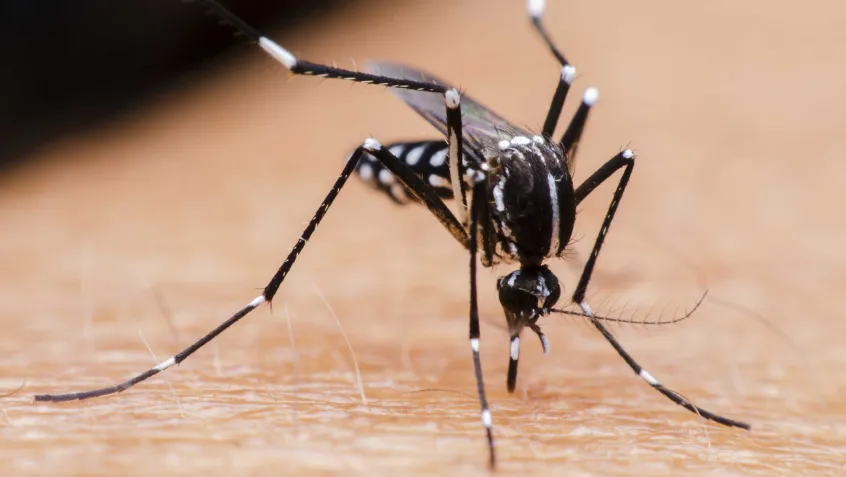
Summer is here, which for many may spell more time outdoors hiking, walking, fishing, boating, and relaxing. However, these warmer temperatures bring more than just people outside—insects that carry disease, like mosquitoes and ticks, are also more likely to be out and about in the warmer weather. Read on to learn about how to protect yourself and your family from vector-borne diseases found in the United States, such as Lyme disease and West Nile virus.
Mosquitoes
Mosquitoes and Disease
Aside from itchy, painful welts, these pests can also expose their animal food sources to disease and parasites. The female mosquito can lay several hundred eggs on the wall of a water-filled container, which stick to the container walls like glue and can last through up to eight months of drying conditions, such as through the winter in the southern United States. Once hatched, these eggs develop into adult mosquitoes over the course of seven to 10 days, at which point the females will bite people and animals to obtain blood to produce more eggs. When feeding on an animal's blood, the mosquito can pick up diseases that animal already has, such as birds that carry West Nile virus. When the mosquito goes to feed on a second animal, it can infect that second animal with the diseases found in the blood of the first, which is how West Nile is spread from birds to humans and other animals, and how West Nile can be further spread among avian populations. While there are many diseases spread by mosquitoes globally, four that have a record of being transmitted in the United States are:
Staying Safe from Mosquito Bites
Different types of mosquitoes are capable of transmitting different diseases—the Aedes aegypti and Aedes albopictus species are responsible for spreading Chikungunya, Dengue, and Zika viruses, and while these species primarily bite during the daytime, they have also been known to bite at night, as well. Multiple mosquito species in the Culex genus can carry West Nile virus, and these species bite from evening to morning.
To protect yourself and your family from mosquito bites, CDC recommends applying an EPA-registered insect repellent, which you can read more about at the bottom of this article, and wearing long-sleeved shirts and long pants. In conjunction with the use of personal protection, you can also take steps to protect your home from mosquitoes, such as using screens on windows and doors, taking care to note and repair any tears in the screens. Reduce available breeding ground for mosquitoes by covering, or emptying and scrubbing any containers which may collect water in and around your home, such as pots, buckets, or birdbaths. If you have a septic tank, repair any cracks or gaps, and use wire mesh with holes smaller than an adult mosquito to cover open vent or plumbing pipes.
Ticks
Ticks and Disease
These pests require hosts—a larger organism whose blood they feed on, which can include mammals, birds, reptiles, and amphibians. Potential host animals are identified by detecting their breath, body odors, body heat, moisture, or vibrations—ticks tend to hang out on well-traveled paths, monitoring their surroundings for these host identifiers. Holding onto blades of grass with their back legs, the tick will reach its first pair of legs out into the air, waiting to attach itself to a passing target. Once aboard an appropriate host, the tick will find a suitable area of exposed skin and feed on its host blood over the course of several days, which can lead to an exchange of bloodborne diseases that the tick has picked up from a previous host or contracted from its current source. When the feeding is complete, the tick will drop off from its host, and can take any bloodborne pathogens acquired from there to its next animal food source. There are many different tick species found globally, but only a handful bite and transmit diseases to humans in the United States. The diseases to which ticks can expose their hosts can be quite serious, including:
Staying Safe from Ticks
While ticks can be a problem year-round, they are most active in the warmer months, generally from April to September. The best way to keep yourself and your family safe during this high tick-activity time is by reducing your exposure to these pests. Ticks like wooded, brushy areas with high grass, so either avoid these areas, or walk in the center of the path and wear long socks and pants while hiking to prevent exposing bare skin to ticks looking for hosts. CDC recommends that these tactics be combined with the use of an insect repellent. See the bottom of this article for guidance on choosing an appropriate repellent.
When you return from the outdoors, take a shower as soon as possible to wash off any ticks that may be crawling on you, and after your shower, complete a full-body tick check with the help of a mirror. Your gear and pets should also be checked for ticks, as these opportunistic pests can return at a later point to attach to your clothes or body. Once the tick check is complete, wash your clothing in hot water, and tumble-dry on high heat for at least 10 minutes to kill any lingering ticks.
If you have found a tick already embedded in your skin, follow these steps from CDC to safely remove it.
Insect Repellent
The US EPA compiled a searchable guide to EPA-registered insect repellents, taking into account the length of your anticipated exposure to the pest and the type of pest you're trying to avoid. Learn more about the guide here.
Sources:
- CDC. n.d. “Mosquito Life Cycle.” US Department of Health and Human Services. http://www.cdc.gov/zika/pdfs/mosquitolifecycle.pdf
- CDC. n.d. “West Nile Virus Transmission Cycle.” US Department of Health and Human Services. http://www.cdc.gov/westnile/resources/pdfs/13_240124_west_nile_lifecycle_birds_plainlanguage_508.pdf
- CDC. 2015. “General Questions About West Nile Virus.” US Department of Health and Human Services. Accessed May 31, 2016. http://www.cdc.gov/westnile/faq/genquestions.html
- CDC. 2015. “Geographic Distribution of Ticks that Bite Humans.” US Department of Health and Human Services. Accessed May 31, 2016. http://www.cdc.gov/ticks/geographic_distribution.html
- CDC. 2015. “Help Control Mosquitoes that Spread Dengue, Chikungunya, and Zika Viruses.” US Department of Health and Human Services. http://www.cdc.gov/zika/pdfs/control_mosquitoes_chikv_denv_zika.pdf
- CDC. 2015. “Life Cycle of Hard Ticks that Spread Disease.” US Department of Health and Human Services. Accessed May 31, 2016. http://www.cdc.gov/ticks/life_cycle_and_hosts.html
- CDC. 2015. “Preventing Tick Bites.” US Department of Health and Human Services. Accessed May 31, 2016. http://www.cdc.gov/ticks/avoid/on_people.html
- CDC. 2016. “Mosquito Bite Prevention (United States).” US Department of Health and Human Services. http://www.cdc.gov/chikungunya/pdfs/fs_mosquito_bite_prevention_us.pdf
- CDC. 2016. “Zika Virus Disease in the United States, 2015-2016.” US Department of Health and Human Services. Accessed May 31. http://www.cdc.gov/zika/geo/united-states.html
- US EPA. 2016. “Mosquito Life Cycle.” Accessed May 31. https://www.epa.gov/mosquitocontrol/mosquito-life-cycle


